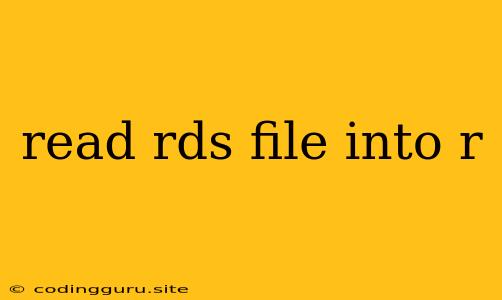Importing Data From RDS Files into R: A Comprehensive Guide
The ability to import data from various sources into R is crucial for data analysis and manipulation. One common format encountered is the RDS file, a native serialization format for R objects. This guide will provide a step-by-step walkthrough on how to read RDS files into R, along with explanations, tips, and examples.
What are RDS Files?
RDS files, short for "R Data Serialization" files, are used to store R objects in a compressed binary format. This format allows for efficient storage and retrieval of data structures, including vectors, matrices, data frames, lists, and even entire R environments.
How to Read an RDS File into R
The primary function for reading RDS files in R is readRDS(). This function takes the path to the RDS file as an argument and returns the stored R object.
Example:
# Load the RDS file into an object called "my_data"
my_data <- readRDS("data.rds")
# Print the structure of the loaded data
str(my_data)
In this example, "data.rds" is the name of your RDS file. Replace this with the actual filename and location.
Handling Errors and Issues
Sometimes, you might encounter issues while reading an RDS file. These could be due to:
- Incorrect file path: Double-check the file path and ensure that it is correct.
- Corrupted file: The RDS file might be corrupted if it was saved improperly or was interrupted during the saving process.
- Version incompatibility: If the RDS file was created using an older version of R, it might not be compatible with your current R version.
Tips for Efficient Data Import
- Relative vs. Absolute Paths: Using relative paths can make your code more portable, while absolute paths provide more clarity.
- Error Handling: Incorporate error handling using
tryCatch()to gracefully handle potential errors and continue with your analysis. - Data Size: For very large RDS files, consider using methods for loading data in chunks or using tools like the
data.tablepackage for efficient handling.
Examples of Reading Different Data Structures
Here are examples demonstrating reading various R objects from RDS files:
1. Data Frame:
# Reading a data frame from an RDS file
my_df <- readRDS("data_frame.rds")
# Print the first few rows of the data frame
head(my_df)
2. Matrix:
# Reading a matrix from an RDS file
my_matrix <- readRDS("my_matrix.rds")
# Print the dimensions of the matrix
dim(my_matrix)
3. List:
# Reading a list from an RDS file
my_list <- readRDS("my_list.rds")
# Print the names of the elements in the list
names(my_list)
Beyond readRDS(): Working with Complex Data Structures
While readRDS() handles most common scenarios, you might encounter situations where you need to interact with more complex data structures within an RDS file. In these cases, you can use the load() function, which allows you to load an entire R workspace saved as an RDS file. This approach can be useful for loading multiple objects or entire environments stored in a single RDS file.
Example:
# Load all objects from the RDS file into the current environment
load("my_workspace.rds")
Conclusion
Reading RDS files into R is straightforward using the readRDS() function. Understanding the format and its functionalities allows you to efficiently import and manage your data for further analysis and manipulation within the R environment. Remember to handle errors gracefully, explore advanced options for large datasets, and choose the appropriate technique for your specific data structure.
